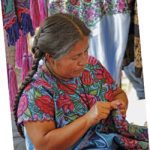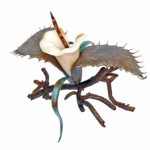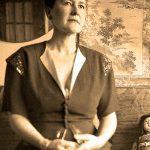DIANE van der ZANDEN—Colima Sculptor
By An Anonymous Source
Tria: Woman Singers by D. van der Zanden
Tucked into the mountains near the Volcan de Fuego not far from the Jalisco-Colima border,you will discover a hidden gem: the artist’s workshop-atelier Arenas. Gifted artist, Diane van der Zanden, has been pursuing her unique vision since she first put crayon to her mother’s walls. In her idyllic – and ecologically-friendly, mountain retreat where she [and husband, Oscar Rogelio Caraballo Rodriguez] produce much of their own food – she creates sculptures in her tranquil studio using a technique she developed here in Mexico. It wasn’t something she planned, and it took her years to refine.
Her exquisite work focuses on the human body, primarily women’s bodies. She explains. “I love the human body; it is magnificent. It is also the hardest thing to do well. I want to show women’s natural bodies as they really are, as an antidote to the false and hateful images that are often portrayed.” Gifted in both art and music, she knew she wanted to be a sculptor the first time she worked with clay when her mother enrolled her in a clay sculpting summer class at age 11.
Diane arrived in Colima as a successful professional, showing her work in juried shows across the U.S., and actively selling it through her website. With her natural gifts, and the skills she’d developed at various U. S. colleges and universities, she sculpted in all the standard materials – clay, plaster, bronze, resin, etc. – and also taught art classes. But life in San Francisco had its problems. So, in 2007, she and her husband, originally from Colima, decided it was time to move to Mexico as they’d always planned.
As they scoured the countryside for the perfect piece of land, she began the quest for suitable clay to continue using her preferred material. Despite thorough research, she found nothing that met her rigorous requirements, though she tried everything available. She was reduced to ordering from the US but with this option endured supply unreliability and high costs.
Her problem was not simply unavailable materials, but also an unsuitable climate. Colima is hot and humid. The first house she lived in had a southern exposure and her studio was metal-roofed, so her plasticine models melted. The only kilns available for firing her work were so unevenly heated that most pieces either cracked or exploded.
After five years, at a low point in her struggle, a writer friend introduced her to the wonders of You Tube. One day as she surfed, she came upon a video about Venetian masks (in Portuguese which she doesn’t speak but it bears sufficient similarity to Spanish that she got the gist). The mask maker was working with flat molds, using paper and paste.
The proverbial light bulb went on. “Aha,” she thought, “I could use a similar technique in three dimensions to produce my sculptures.” Starting with an existing clay sculpture mold, she layered it with small pieces of art paper using craft glue. Eureka! This turned out to be the breakthrough that changed her art. Using the technique, she could produce sculptures that satisfied her aesthetic.
It was not easy. It took a lot of experimenting to find the right paper; the best glue; the finishing materials; the suppliers; the technique to prepare the plaster molds and layer the paper; assemble the sculpture from the pieces; and finish the artwork once it was roughly constructed.
She describes her method as a ten-step process:
Sculpt a piece in plasticine;
Cut the sculpture apart;
Make plaster molds for each part;
Glue several layers of craft paper into the molds and dry;
Release each piece from its mold;
Cut the flanges from each paper piece with precision;
Assemble the paper pieces of the sculpture around an internal armature;
Refine the assembled piece with paper and paste;
Paint the piece; and
Mount on a base.
The pieces satisfy her aesthetic sense, requirement for structural integrity and technical perfection. They also reflect the technique she has adopted, and her determination that women should not be seen to be ‘less than,’ from which she suffered in her youth.
She has shown her work at the Pinacoteca and IUBA [Art School] in Colima and sold pieces to international clients. She is working on 12 pieces and plans a show in the next year.
- April 2024 – Issue - March 31, 2024
- April 2024 – Articles - March 31, 2024
- April 2024 - March 31, 2024










